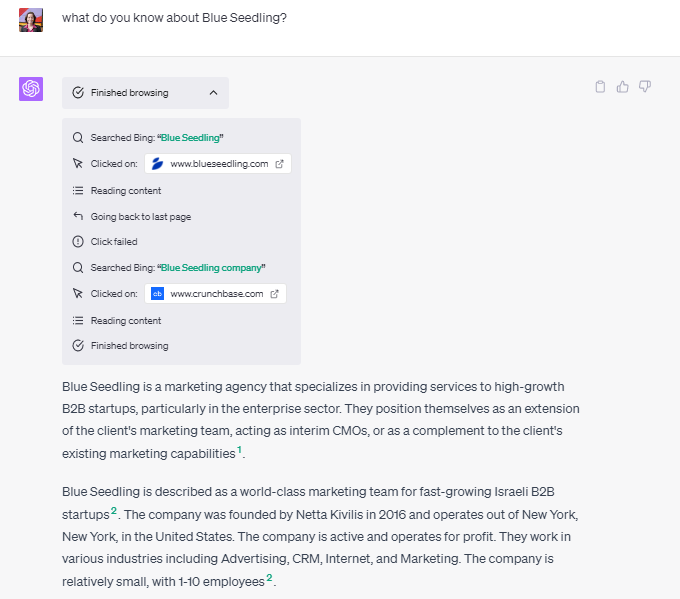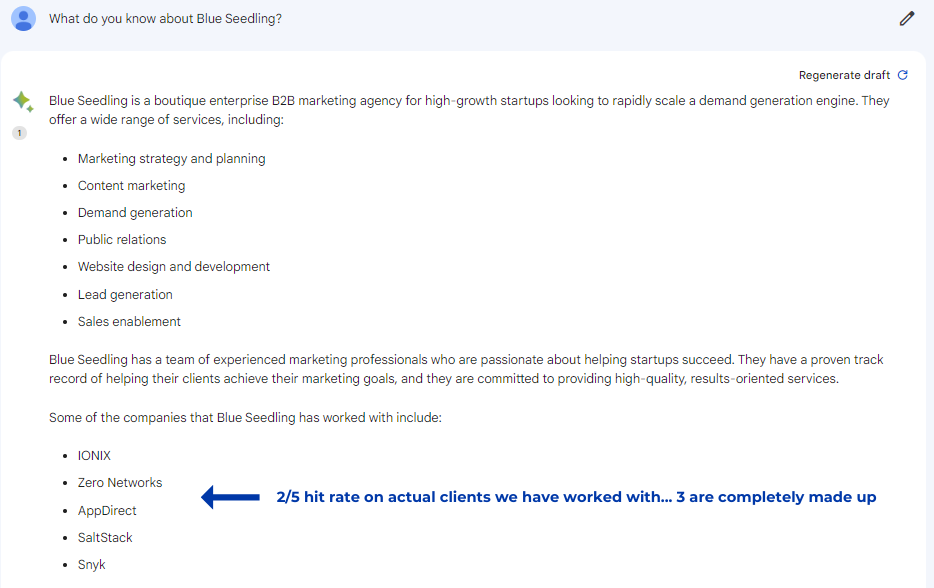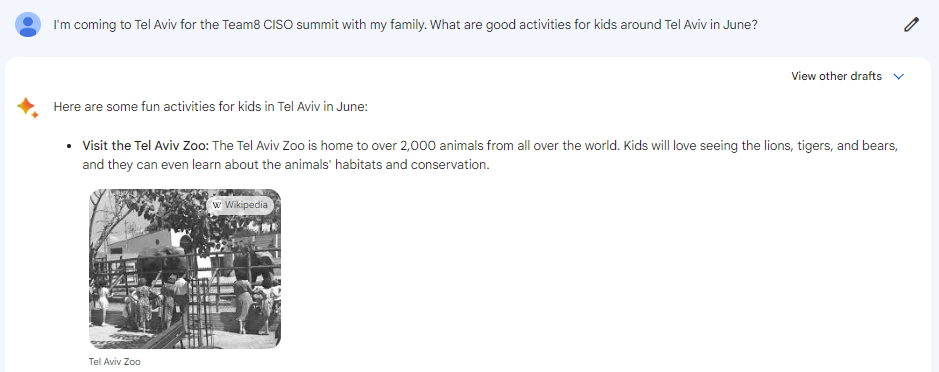Today, I am putting two AI behemoths, Google Bard and OpenAI ChatGPT (GPT-4), to the test. I used both platforms for everyday marketing tasks, with an emphasis on creating B2B marketing content – specifically, writing this blog post: Why strong marketing is a must for every new Generative AI startup.
Before we get to the play-by-play showdown, let’s not bury the lede: Right now, there’s no way to whip up a brand new piece of content using either of these tools without pouring a good chunk of time and effort into guiding the tool, tweaking the text, and really honing the language. That said, if you’re a B2B marketer tasked with creating content, you should absolutely turn to these tools to boost your productivity, help with ideation and brainstorming, improve your writing, and make the writing process more fun.
At the end of the post you’ll find two handy cheatsheets:
A summary of the pros & cons of each tool
A guide for deciding when to use each tool according to the content use case
The showdown: Google Bard vs OpenAI ChatGPT in B2B content creation –
a three-round battle
1) Round one – Conversation continuity: Bard doesn’t save previous conversations 😱
Bard saves previous individual prompts but not the responses, and not in one contextual conversation. At least for now, the prompts are stored under “Bard Activity,” a separate page created as a way to delete them for your data protection & privacy.
Bard’s UI is basically one continuous conversation that lasts through one session, and that’s it. This is in contrast to ChatGPT, where all conversations are saved – both prompts and responses. You can come back to any conversation an hour, week, or month later, and simply continue it with all the saved context. You can also grab past responses easily, simply copying any text to paste elsewhere. (Moreover, ChatGPT recently introduced the ability to share links to conversations – incredibly useful and a potential “10X feature”.)
This is a huge downside of Bard, as this setup makes it impossible to resume a conversation in subsequent sessions, forcing users to recreate dialogues and contexts, which is highly impractical and time-consuming. It also gives different answers for the same prompt, so re-creating the exact same conversation is also not possible.
Until this is fixed, my use of Bard will be limited.
The winner (in a knockout): ChatGPT
2) Round two – Tone of voice: Bard’s is less annoying, but ChatGPT can be taught
ChatGPT’s default tone of voice is a combination of bland and sales-y – it’s still a mystery to me how it’s able to combine the two extremes in the worst possible way.
Here’s a representative ChatGPT example:
“Marketing is indispensable for startups, and for any generative AI startup, it becomes quintessential. Amid a clamorous landscape abundant with competitors, your product isn’t your unique selling proposition – it’s your marketing strategy.” – Seriously ChatGPT, can you get more buzzword-y than this?
Bard’s default tone of voice is more neutral and matter-of-fact. Here’s how Bard tackled the same sentence:
“Marketing is always important for startups, but for generative AI startups, it is going to be even more critical, as the technology is still in its early stages and there is a lot of competition in the market.“
This makes it faster and easier to edit Bard’s copy to match your desired tone of voice.
And yes, I know that I can instruct both to write as if they were Jerry Seinfeld or Steve Jobs or A brash Startup CEO whose English isn’t very good. But in my experience, these still fall short of the tone of voice marketers employ for their companies (and themselves).
That said, ChatGPT is making impressive progress with being able to learn and adopt a tone of voice through examples, past texts, or dedicated plug-ins (check out Anyword as an example, especially if you’re doing performance marketing).
The winner: Bard, with ChatGPT nipping on its heels
3) Round 3 – Data coverage & accuracy: Both hallucinate, but Bard browses the internet faster
When asked “What do you know about Blue Seedling” (our agency), ChatGPT took a few minutes to browse the internet, while keeping me abreast of its (slow) progress. It ended up with a correct answer, including pointers to its sources (blueseedling.com and CB Insights).


The resulting answer was great – but the experience of waiting two minutes for it was strange. This will likely get better over time as ChatGPT consumes more of the internet.
Hallucinations: ChatGPT’s hallucinations have been widely documented, but I was surprised to see Bard hallucinating even more. Dude, just Google it! 😉
In the example above about Blue Seedling, Bard came up with made-up founders and clients for Blue Seedling.

And here’s another example – my favorite Bard hallucination (though I do love Bard’s incorporation of images – a cool feature ChatGPT currently doesn’t have):

(Tel Aviv’s Zoo, according to the very wikipedia article Bard links to, closed in 1980).
The winner: ChatGPT
The different behaviors and capabilities led me to synthesize a list of recommendations for which tool to consider for which content task.
Cheatsheet: Bard vs ChatGPT for B2B content creation – Which tool should you choose and when?
| Use Case | Preferable Tool | Reasoning |
| Drafting a detailed whitepaper | ChatGPT | Better conversation continuity for complex contexts and more accurate research |
| Writing a blog post – from a brief to a complete product | Both | ChatGPT for maintaining context over several sessions, Bard for tone of voice |
| Quick market research | Google Bard | Faster browsing capabilities |
| Editing and improving tone and style | Google Bard | Neutral and fact-based default tone, easier to edit |
| Collaborative projects with shared dialogues | ChatGPT | Ability to share conversation links with others |
| Creating a script for a marketing video | Google Bard | Maintains prompt structure and easier tone editing |
| Drafting a series of interconnected blog posts | ChatGPT | Better at handling contexts over extended conversations |
| Synthesis and new content generation | ChatGPT | Able to “understand” complex ideas and generate more coherent content |
Cheatsheet: Bard vs ChatGPT for B2B content creation – Feature comparison
Here’s a table summarizing the differences highlighted in this post:
| Feature | ChatGPT | Google Bard |
| Conversation Continuity | Saves full conversation history, allowing for easy resumption of previous dialogues | Saves prompts but not responses; lacks continuity in conversation history |
| Tone of Voice | Default tone is a mix of bland and buzzword-laden | Neutral and fact-based default tone, easier to edit |
| Internet Browsing | Slower but more accurate when browsing the internet for information | Faster but prone to errors or “hallucinations” when browsing the internet |
| Prompt Structure Adherence | May restructure prompts | Tends to maintain the structure of prompts more effectively |
| Data Protection and Privacy | Conversations are saved, can be revisited anytime | Prompts saved under “Bard Activity” for data protection, not for continuity |
| Sharing Conversations | Allows sharing of links to conversations | Does not have the feature to share conversation links |
| Handling Complex Contexts | Better at handling contexts over extended conversations | Not ideal for extended conversations due to lack of conversation history |
| Customization of Writing Style | Can be instructed to mimic specific styles, but results may vary | Can be instructed to mimic specific styles, but results may vary |
| Use Case | Better for tasks requiring conversation continuity and more extensive research | Better for tasks requiring quick information and editing for tone |
The bottom line
Between Bard and ChatGPT, there’s no clear winner yet for B2B content creation. ChatGPT does better at conversation continuity and in-depth research, albeit at a slower pace, while Google Bard offers a more neutral tone that’s easier to edit and faster browsing capabilities with some accuracy trade-offs. My recommendation is to continue giving both a shot depending on the use case, and closely watch developments in this rapidly-changing space.








